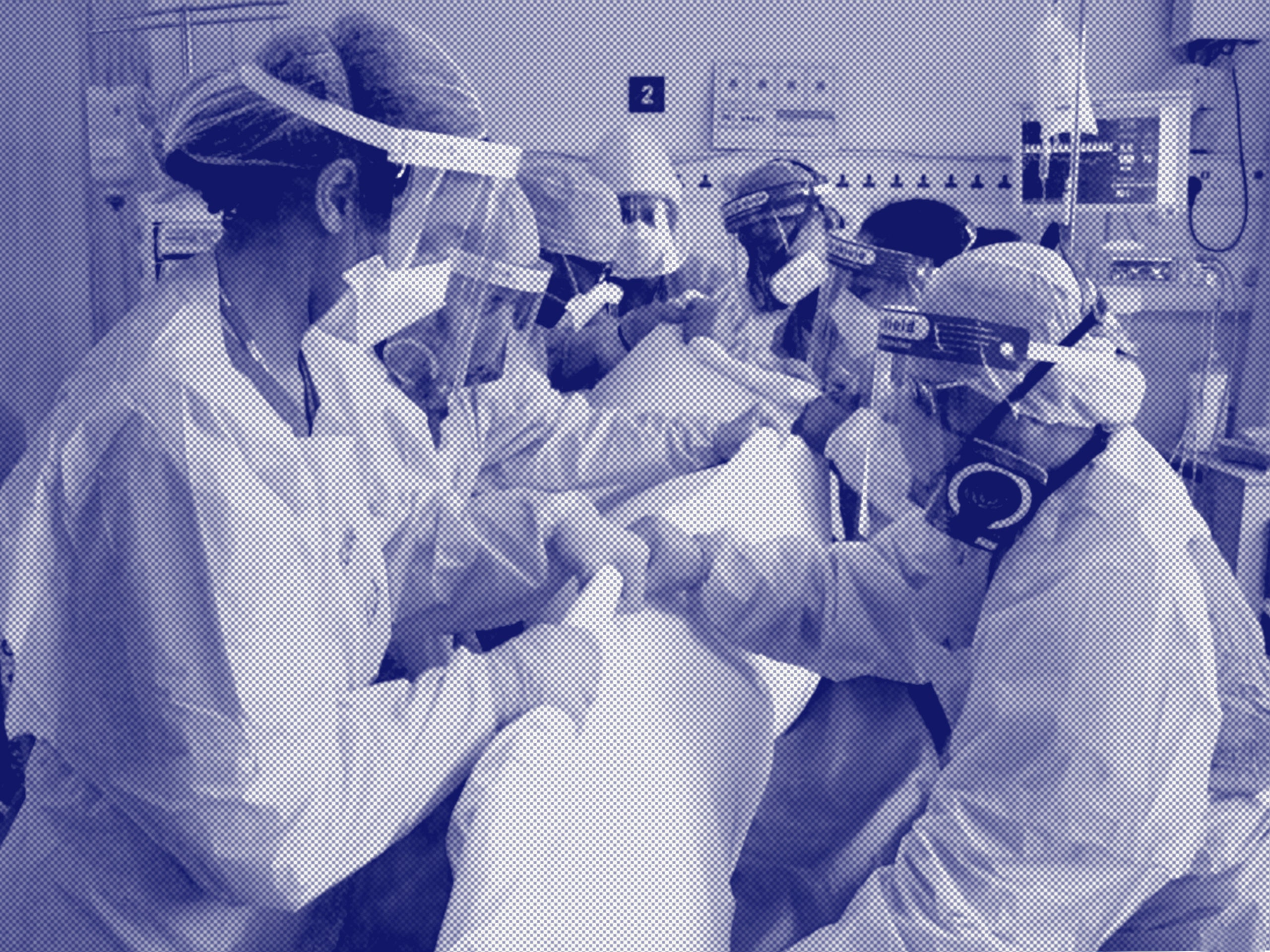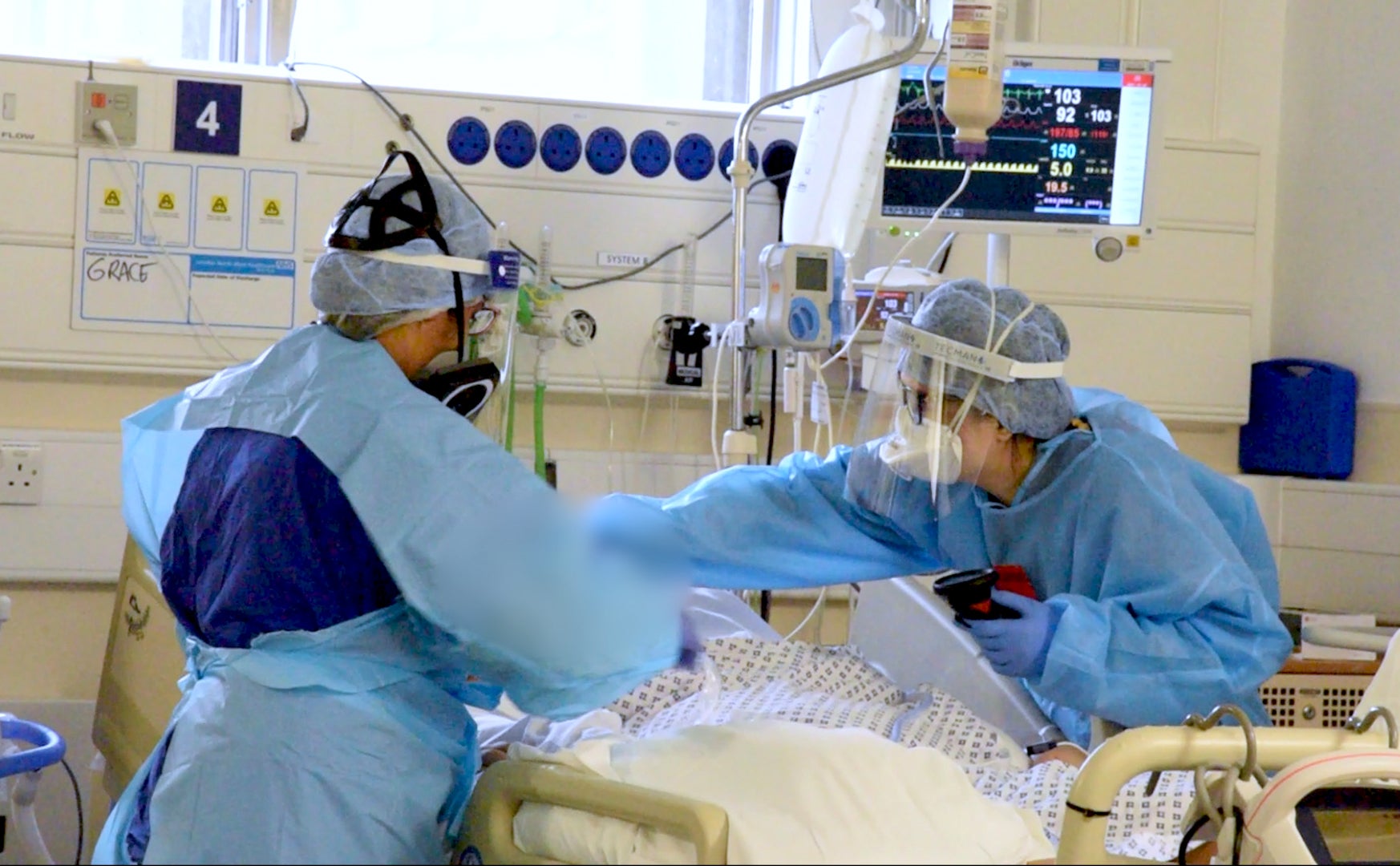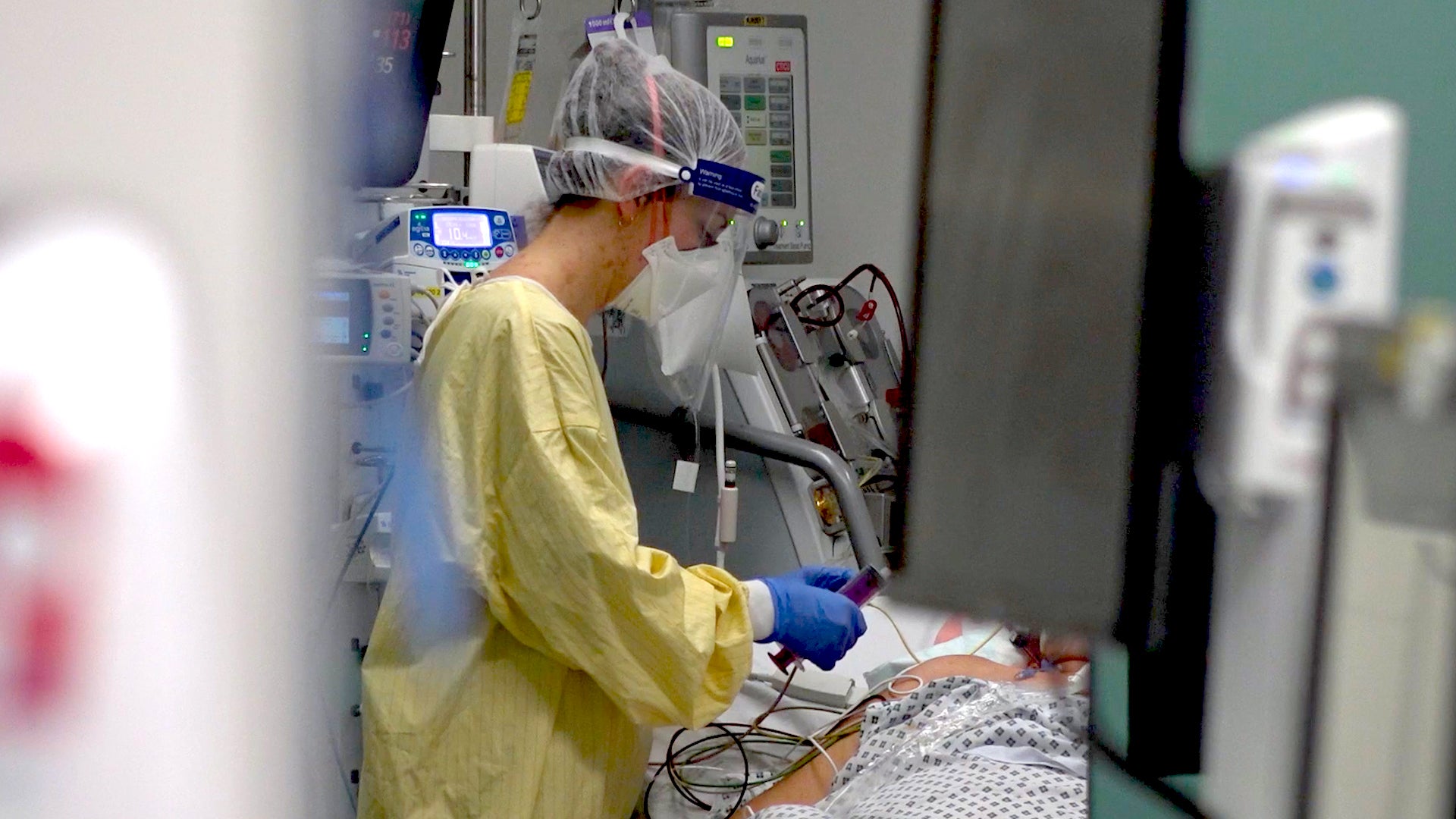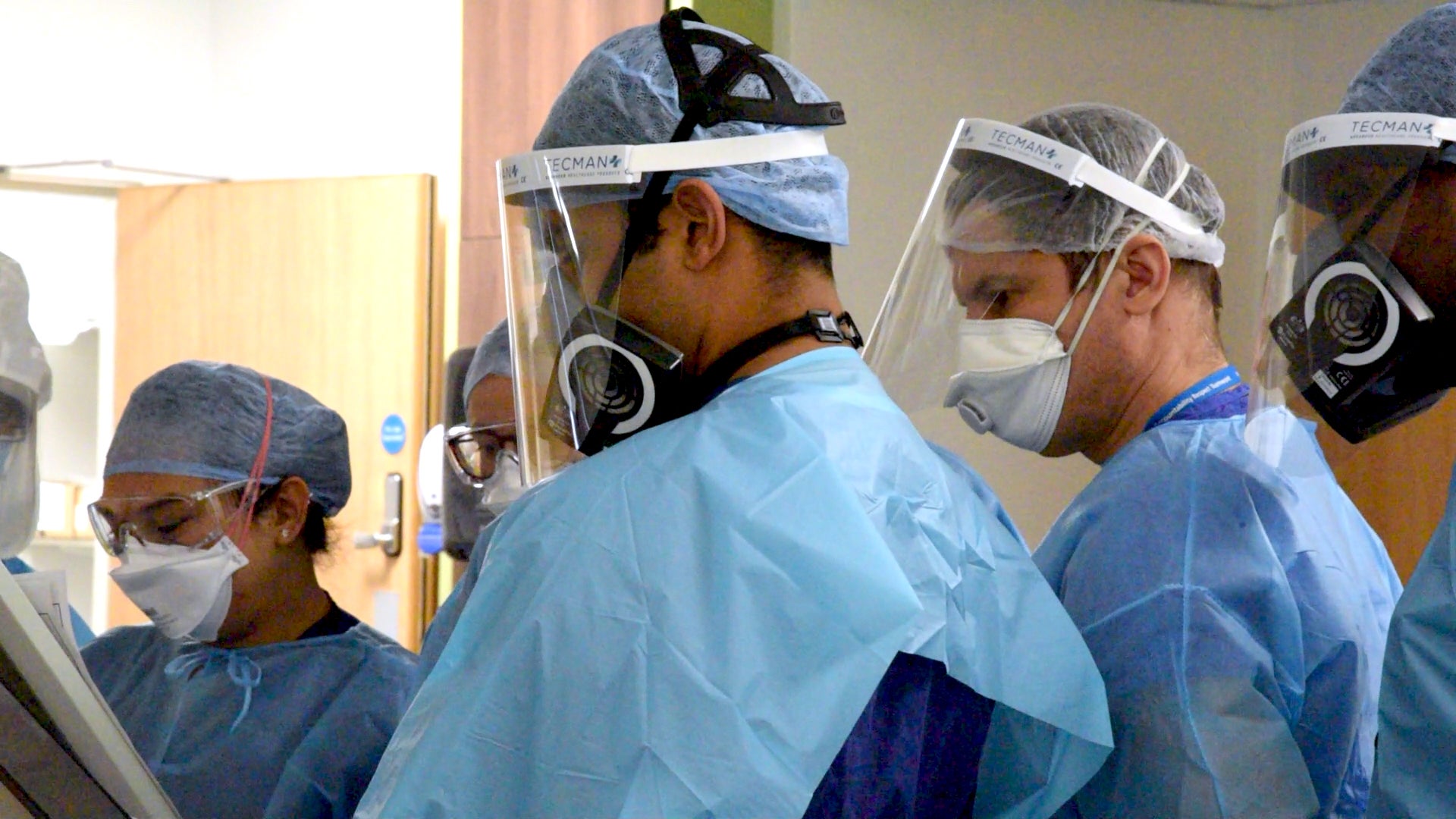‘Like going to war’: Life and death on a Covid intensive care ward
Special report: As admissions peak, Health Correspondent Shaun Lintern goes into an NHS hospital to find out what doctors and nurses face on the coronavirus front line


Your support helps us to tell the story
From reproductive rights to climate change to Big Tech, The Independent is on the ground when the story is developing. Whether it's investigating the financials of Elon Musk's pro-Trump PAC or producing our latest documentary, 'The A Word', which shines a light on the American women fighting for reproductive rights, we know how important it is to parse out the facts from the messaging.
At such a critical moment in US history, we need reporters on the ground. Your donation allows us to keep sending journalists to speak to both sides of the story.
The Independent is trusted by Americans across the entire political spectrum. And unlike many other quality news outlets, we choose not to lock Americans out of our reporting and analysis with paywalls. We believe quality journalism should be available to everyone, paid for by those who can afford it.
Your support makes all the difference.On the intensive care ward of Northwick Park Hospital in north London, physiotherapist Mirko Vracar stands among dozens of coronavirus patients, surrounded by a cacophony of beeping alarms and hissing machinery. The patients lie comatose, ventilators breathing for them, while doctors and nurses speak in urgent, hushed tones, their voices muffled behind masks.
For Mirko, redeployed to help the overstretched staff, the work is difficult and the stakes could not be higher. Since Christmas he has spent five days a week on these wards, working in a team that “prones” these patients – moving them on to their fronts so their Covid-ravaged lungs can breathe a little easier. They do this as many as 25 times a shift.
“They are stressful situations,” the 32-year-old tells The Independent. “Especially when you see the young people, and you know you can’t really do anything to help them.”
The work is intense and non-stop; the sheer scale of suffering difficult to bear.
“You come home, you’re just knackered. You can’t do anything, my kids want to play with me, I can’t. Your social life is zero and then you come back to work, and you have to go again,” he says.
“You keep seeing the same patients over a couple of days, you read their names, take a little bit of their history. The more you do that, the more you take it to heart, so I try not to know anything about them – to protect myself, really.”
As Britain’s second coronavirus wave reached its peak, The Independent was granted rare access to these intensive care wards to see how staff at Northwick Park, and across the NHS, fight minute by minute to provide life-saving care.
Doctors and nurses told how they have coped with relentless pressure over the past months – and how they think the health service can bounce back from a crisis like no other.
A year-long state of emergency
Northwick Park became the first NHS hospital in the country to declare a major incident as it was overrun by coronavirus last March, shortly before the first lockdown. Nearly a year later, the emergency is still ongoing.
In a pandemic that has been defined by figures – case numbers, tests, deaths, infection rates, vaccinations – it is the statistics that illustrate the scale of the task that has faced NHS workers at Northwick Park, which serves a population of more than a million across the boroughs of Brent, Ealing and Harrow.
39,222
Covid patients in NHS hospitals on 18 January
Since 3 March, when the first patient arrived, almost 4,200 people have been admitted to the wards of London North West University Healthcare NHS Trust, which runs Northwick Park, because of coronavirus – an average of 12 a day. Of these, a total of 787 have died; nearly a fifth of those admitted.
When the public began to clap for carers last March, recognising the strain that health workers were under, the number of Covid patients in hospital across the country stood at around 7,200. The first wave peak, on 12 April, was 21,686 patients.
In the latest surge, which began in December as a more transmissible variant emerged, the numbers reached almost double that across the UK – hitting 39,222 on 18 January.

This has pushed hospitals to their limit. Some, particularly in the southeast, were overwhelmed by the numbers needing critical care. Patients in Kent and surrounding areas were ferried to hospitals as far away as Bristol, Leeds and Oxford to try to relieve the pressure. In London, as Covid patients struggled to breathe, the demand for oxygen became so great that piping systems buckled under the strain. In Woolwich and Romford, hospitals were forced to divert emergency patients elsewhere as a result.
It’s not just hospitals that have been hit hard; the London Ambulance Service has been forced to leave hundreds of emergency 999 calls waiting hours for a response.
“It hit here very early on,” says, Dr Ganesh Suntharalingam, the trust’s clinical director of intensive care. “We saw cases surging here well before lockdown started. It is unprecedented, both in the nature of it, and the size and scale and speed of onset.
“With Covid you can see double the mortality for a normal ICU admission. So more people are dying. And from the point of view of the staff at the bedside, they’re dying in a way that is more isolated from their families. Staff are having to act for the family as well as the patient.
“A lot of people were very distressed. Especially those who came from other wards and students who had never worked in intensive care before. It can have a big impact.”
‘It’s like we’re going out to war’
This unprecedented pressure on hospitals has needed an unprecedented response. At Northwick Park, intensive care beds have been more than doubled, from 22 to 48. The number of beds in respiratory wards has trebled; all but a handful are filled with Covid patients. In England, the number of critical care beds has been expanded by taking over operating theatres, recovery areas and general medical wards.
In the NHS, an extra bed is more than simply furniture and physical space, it is a doctor taking extra shifts and working longer hours in the hardest conditions of their lives; it is a nurse having to look after two or three critically ill patients at a time rather than one.
Some of Northwick Park’s team of estates staff lived on site for three months during the first wave as they worked around the clock to make wards and corridors Covid-proof. They built entrances to wards, sealing some off. There has also been a huge background operation to keep staff supplied with essential kits, medicines and equipment.
Entering the 33-bed intensive care ward is like entering a different world. A hastily constructed partition signals the entrance, with transparent plastic sheeting that has been zipped floor to ceiling. It is the shield between life outside and the ward – truly the front line of this pandemic – where patients infected with Covid-19 are fighting for survival.
“I have never experienced, and never would want to experience this, in a lifetime, it is unbelievable,” says healthcare assistant Michelle Piper. “After all this time, people cannot believe what is actually going on. They think because the corridors are empty, there’s nothing much going on. But when you actually come inside of the hospital, push the doors, it’s all happening, it’s like we are going out to war.”
Protective gloves, scrubs and an apron are needed before passing through, but feel alarmingly flimsy. One coronavirus patient, a young woman, lies with her head turned to the side, tubes coming out of her nose and mouth. The ventilator breathes for her; she would die without it. Even with its help, her lungs still struggle to get enough oxygen because of the physical damage wrought by the virus. She has hypoxia, or low blood oxygen, with a saturation below 90 per cent. A healthy person can expect a level of 98 or 99 per cent.
Just behind her head, a bank of infusion pumps delivers myriad drugs to keep her muscles paralysed and blood pressure at the right level, supporting her body as it fights the effects of the virus. These need constant monitoring, almost minute by minute, by nurses.
On her right side, a tube filled with blood from a vein snakes out of the bed and into a tall dialysis machine, where it is mechanically filtered before being returned to the body. It has taken the role of her kidneys, which have also been damaged. She is in a critical condition. There are two more patients next to her – they too are critically ill.

“We’ve seen a husband and wife, who were both infected and sick, here in ICU at the same time and unfortunately, they sadly passed away,” says Mina Bharal, an intensive care dietitian. “Those things stick in your mind. We’ve had patients that are young, and patients that are in ICU for 40 or 50 days. Those patients you always worry about and there are patients in here right now who, when I go home, I can’t help but think about and hope they do all right today. I don’t sleep very well.
“I’ve never experienced anything like this at all in over 10 years in intensive care. There’s currently quite a high workload. There’s a lot of pressure and making sure that we see all of these patients… there’s so many sick patients.”
She worked through the first wave, with no break until August, when her managers told her she needed to stop. “You don’t realise you need the rest until you’ve actually had a rest.”
Fighting through a crisis
On the opposite side of the bay, the proning team is getting ready to turn a patient. Led by a consultant anaesthetist, the team, made up of redeployed staff, prepare the male patient with care. These turns are vital to help his lungs but also to relieve pressure on the body after hours lying in the same position.
The staff wrap the patient in sheets, working as one to roll him in stages, with a careful eye on the monitors. They will do this dozens of times a day.
Caring for Covid patients in intensive care is about buying the body time. Some new treatments help combat the disease, but there is no magic cure. Covid can be especially cruel – sometimes patients appear to be recovering but suddenly deteriorate with no explanation.
The staff work methodically, moving with purpose. But occasional laughter and camaraderie breaks through. Everyone talks of the team-working approach that has got them through the crisis: it was the support they needed and gave to each other.
Their stoicism in the face of pressure is remarkable, but probe deeper and the battle scars of the past year emerge.
“As you can see from around us, it’s affecting anyone and everyone,” says Deeptika Satchi, who has worked on intensive care for 18 years as a physiotherapist. “You see people you can relate to, that your family members can relate to. I think that’s when it hits home and that’s what sends us home with a heavy heart. Just the extent of it.”
The scale of the harm caused by the virus is what the staff talk about. They are used to seeing sick patients, but the sheer numbers, sometimes from the same family, mean this is very different to what they have experienced before.
Many on the intensive care unit have been redeployed from elsewhere. They are given tasks to relieve the pressure on nurses. For some of them, this is a new and alien environment.
Trish Mukherjee, head of critical care nursing, says staff have given their all over the past year. “The sheer numbers have been just phenomenal. That was very, very difficult because the patients were just coming in. And they were coming in much faster than we expected. We were challenged, don’t get me wrong. But we remained safe. And I’m proud to say that.”
On its worst day, the hospital’s intensive care nurses were so short-staffed they were forced to look after four patients each – a normal ratio is one-to-one.
“That was probably one of the most challenging days that we’ve had,” she says. “I stayed on shift and all of my matrons did. I came in to two physios willing to help me until midnight, it was incredible. We had one of our nurses who was on annual leave who came in to help with break reliefs. That sort of thing that people do when it’s a crisis is incredible. I’m speechless when things like that have happened.”
Describing the effect as a “scarring” after the crisis has passed, she added: “We have put in a lot of support for staff. We talk to them and we want to listen to what they’re feeling and what they’re going through so that we can offer the support, because sometimes it’s just listening to them and hearing them.
“We hope that there is an end in sight.”
Knock-on effects
Clare Rowbottom is a speech and language therapist who normally works in the community, but now she too spends her days on the proning team, spending long shifts under protective equipment that leaves you hot and sweaty.
“It’s tiring, hard work. I’m used to seeing unwell people. But it’s a very different way of seeing unwell people here,” she says.
But the 37-year-old also worries about those whose normal care has been disrupted. “I’m always thinking about my patients who aren’t getting seen in the community while I’m in here. We’re building up a longer and longer waiting list, because we’re being asked to come and help here. At some point in the future, we’ll have to go back and see them and work out how we’re going to fit them all in.”
As Covid has taken over the NHS, other treatments have had to fall by the wayside. Outpatient appointments and clinics have been suspended or moved online entirely. Thousands of operations have been cancelled. Surgery for cancer has been delayed. Organ transplants have been stopped. Children’s wards have been forced to take adult patients.

For Phil Tozer, a colorectal surgeon at St Mark’s Hospital, which is run by the same trust, the mounting waits weigh heavily.
“At St Mark’s, we’ve just been through an exercise where we’ve spoken to or tried to speak to everyone on our surgical waiting lists.
“We hate making patients wait, we hate it. It’s awful, it’s obviously much more awful for the patient than it is for us, but it has an impact on you being asked for help and not being able to give it in the timely way that you would like.
“When I talk to someone now about when their operation is going to be, if it’s not an urgent operation, then I tell them that it will be hopefully sometime this year.”
The waiting list for treatment stands at a record 4.5 million. The number of patients who had been waiting a year or more for treatment was 1,613 this time a year ago; now it is more than 220,000.
But coming straight out of one crisis to tackle another is not a realistic ask for staff left burnt out and emotionally scarred by the pandemic. Intensive care clinical director Ganesh Suntharalingam, who is former president of the Intensive Care Society, says: “The risk is we are starting with a high degree of psychological impact and burnout. We’ve got people from outside intensive care to come in to help whose own training has been held back. All these things matter. Restarting things makes absolute sense. But I think we have to be realistic about that. It needs to be prioritised.”
Long Covid is going to be a much bigger problem than we envisaged
In some NHS units, as many as one in five workers may suffer mental health problems as a result of the pandemic, with soaring rates of anxiety, depression and burnout among frontline staff. Some are expected to have symptoms of post-traumatic stress disorder. The virus itself has taken its toll on them. Sickness absence data showed, at its peak, almost 50,000 staff off work, with half of all staff absence due to Covid infection or needing to self-isolate.
Danny Mortimer, chief executive of the NHS Confederation, which represents hospital trusts, told The Independent that Covid had both increased the volume of work for NHS staff and the dependency of the patients. “They are caring for people who are dying in numbers that they’ve never experienced in their careers before. Some people, hopefully a small number, will have been made very ill by what they’ve lived through over this last year and will need access to specialist help. But for the vast majority of people, they will need decompression time.”
The long-term victims
Elsewhere in Northwick Park, away from the intensive care unit, respiratory consultant David Adeboyeku worries for the coronavirus survivors, and the long-term impact of the virus on their health. Over the past weeks and months, he has seen large numbers of patients in beds for weeks struggling to breathe.
“After the first wave, we followed up all the people that had been on ITU. They had acute problems three months out, with memory problems and weakness from being on intensive care, they may have had clotting problems and still have breathlessness where they had scarring on the lungs that hadn’t healed. But then what we suddenly realised from our referral pattern was that there were all these other people that had never been into hospital who had a very classical history of Covid.”

This “long Covid” affects as many as one in 10 patients who have had the virus – some of whom had only minor infections. The National Institute for Health Research found some patients still suffered seven months on from their case of coronavirus, with issues including damage to heart and lungs, and problems with kidneys, livers and skin, as well as breathlessness, chronic fatigue, “brain fog” and anxiety.
Northwick Park is planned as a site for a clinic to provide care to those with long Covid, some of whom may be left unable to work or live their lives normally.
“I think it’s going to be a much bigger problem than we envisaged coming from the community because the symptoms are so varied,” says Dr Adeboyeku. “All of that’s going to need to be funded.”
A path to recovery
With 30,000 patients still in hospitals with coronavirus, the immediate goal is to keep up the efforts to save lives. But inevitably in the months ahead, NHS leaders will need to consider their next steps.
Mortimer, of NHS Confederation, warns the crisis has “touched every part of the NHS”. He says: “It’s affected acute hospitals in their critical care, respiratory wards and general wards. It’s affected ambulance services in terms of delays, its affected mental health services in terms of the demand for their services and affected GPs in terms of disruption to their services and the massive exercise they’ve had to undertake to vaccinate millions of people. It’s also impacted on community services and our colleagues in social care. Everybody has been affected by it.”
Martin Kuper, chief medical officer for the trust that runs Northwick Park, is worried about the recovery pressure that could fall on hospitals.
“It has to be a concern. How do we balance, particularly once this wave is over, the need to resume elective activity with the need for people to have a rest? People are tired, we need to try and help them stay healthy.
“It’s been tough. We’ve been under quite a lot of sustained pressure. We have managed because everyone has worked flat-out. We need some realism about the rate at which we can recover.”
But while hospital leaders look to the future, on the intensive care wards at Northwick Park, staff are focused firmly on the present, working shift after shift to save as many lives as possible in a crisis they know is still far from over.
Join our commenting forum
Join thought-provoking conversations, follow other Independent readers and see their replies
Comments